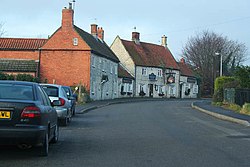Ropsley
| Ropsley | |
| Lincolnshire | |
|---|---|
 Ropsley | |
| Location | |
| Location: | 52°53’46"N, -0°31’36"W |
| Data | |
| Post town: | Grantham |
| Postcode: | NG33 |
| Local Government | |
| Council: | South Kesteven |
| Parliamentary constituency: |
Grantham and Stamford |
Ropsley is a village and ancient parish in the Kesteven part of Lincolnshire. The village is situated approximately five miles east of Grantham, in the wapentake of Winnibriggs and Threo. Since 1931 it has formed part of the civil parish of Ropsley and Humby.[1]
Ropsley is the location of the source of the River East Glen (River Eden).
History
Ropsley was the birthplace of Richard Foxe, the Tudor Bishop who funded the Grammar School at Grantham and Corpus Christi College at Oxford.[2]
A 300-year-old ring dam, ½ mile south-east of the village and identified by a group of trees, was once used as a sheep wash; the blue brickwork of the sheep wash can still be seen. There are paths from the village, past the ring dam, to Little Humby.
There several disused quarries nearby, two of which are situated within the village itself.
Community

There is now one village public house: The Green Man, The Ropsley Fox closed down in 2012. Previous pubs included The Peacock. The village bakery was on the high street for 300 years, one of the oldest in the country, closing in 1979. Now a private house, many people can remember visiting the bakery as children to get the family bread and cakes.
Ropsley village hall has grounds which incorporate a basketball court, a football pitch and a cricket pitch. There is a 12-hole golf course on the outskirts of the village. The village running club is Ropsley Road Runners.
Ropsley war memorial is situated in the centre of the village and dedicated to First and Second World War servicemen. Each year on Remembrance Day a parade, led by a piper, travels from St Peter's Church to the memorial for two minutes' silence.
A number of walks in the Ropsley area run through traditional English woodland, including Ropsley Rise Woods.
Previously there were several small farms in the Ropsley area. Today very little of the land is used for livestock; it is almost all arable farmland, growing crops including barley and oil seed rape.
St Peter's Church

The church of St Peter dates back to Norman times. Some parts of the church appear to be of Anglo-Saxon origin.[3] The building dates back to at least 1380. In the 17th century part of the church was demolished and re built by the vicar of the time, Reverend Francis Furlong, because dry rot was discovered in the walls.[4] Two war memorials are inside St Peter's Church: one commemorates War dead, the second, a stained-glass window, is a memorial to Sgt Pilot of the Royal Air Force, William Philip Dales from Little Humby.
The ecclesiastical parish is part of The North Beltisloe Group of parishes[5] in the Deanery of Beltisloe in the Diocese of Lincoln.[6] From 2006 to 2011 the incumbent was Rev Richard Ireson [7] and from 2012 Rev Mike Doyle.
References
| ("Wikimedia Commons" has material about Ropsley) |
- ↑ "Ropsley and Humby parish council". Lincolnshire county council. http://parishes.lincolnshire.gov.uk/RopsleyandHumby/. Retrieved 7 September 2013. "The "Ropsley & District Parish Council" covers the electorial[sic] area of the village of Ropsley & the hamlets of Braceby, Great Humby, Little Humby & Sapperton. The Ropsley & Humby Ward elects seven councillors & the Braceby & Sapperton Ward one."
- ↑ "Bishop Richard Foxe". Church web site. http://www.stpetersropsley.org/Bishop_Foxe.htm. Retrieved 8 September 2013.
- ↑ Taylor, H M (1978). Anglo-Saxon architecture : volume 3. Cambridge University Press. p. 1110.
- ↑ Historic England. "Church of St.Peter (325721)". PastScape. http://www.pastscape.org.uk/hob.aspx?hob_id=325721. Retrieved 7 January 2014
- ↑ "St. Peter's Church, Ropsley", Northbeltisloeparishes.co.uk. Retrieved 14 May 2012
- ↑ "Ropsley P C C", Diocese of Lincoln. Retrieved 14 May 1012
- ↑ "North Beltisloe Group Council Report for PCC AGMs."; Boothby.org.uk. PDF download required. Retrieved 14 May 2012